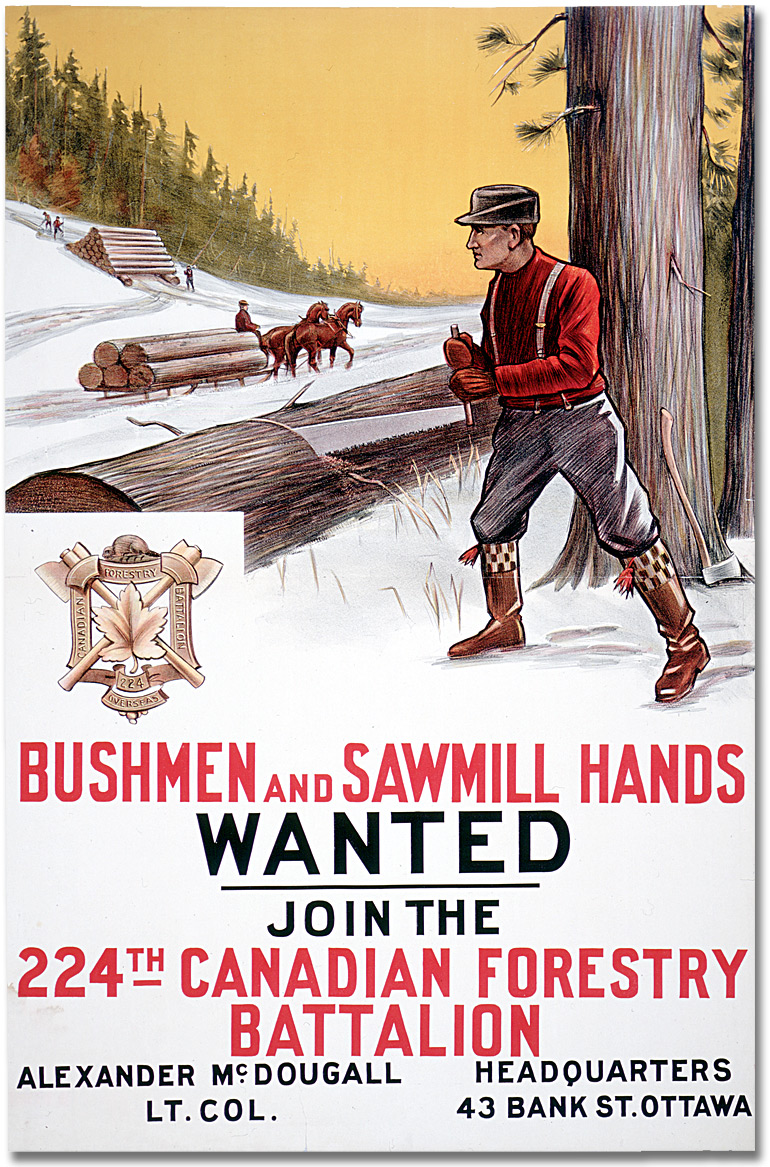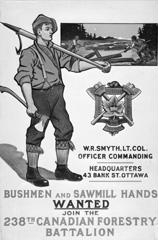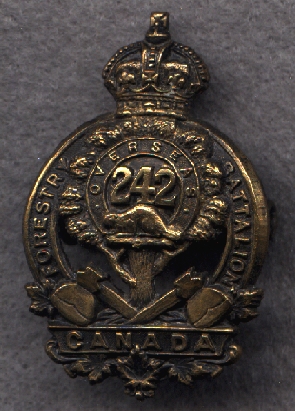Canadian Forestry Corps, C.E.F.
Over 75,000 Canadians that served in WWI never got to France. They either joined late in the war and did not get over in a reinforcing draft before 11 Nov 18, or remained in the UK with the various depot battalions, HQs and units such as UK-based companies of the CFC.
Forest products had been a staple Canadian industry throughout the 19th Century. At times some 65 percent of Canadian exports had been in the form of squared timber and sawn lumber, directed both to British and American markets.
The First World War strained shipping space. France and Britain sought to reduce timber imports by tapping their own forests. However, logging skills were more easily available in Canada. In February 1916 the British government requested that a forestry battalion be raised in Canada for overseas service.
The Dominion acted quickly; 1,600 men were recruited in six weeks; $250,000.00 was spent on logging and milling equipment. The 224th Canadian Forestry Battalion, as the new unit was designated, was sent overseas in several drafts. The first sawn lumber was produced in England on May 13th, 1916.
Three more forestry battalions were raised, but this form of organization proved unwieldy. Ultimately the Canadian Forestry Corps was broken down into 101 companies operating in Great Britain and France. The foresters numbered some 22,000. Attached personnel (Canadian Army Service Corps, Canadian Army Medical Corps, Chinese labourers, employed prisoners of war) brought the total corps strength to approximately 31,000.
Only four Forestry battalions would have nominal (embarkation/sailing) rolls. The 224th sailed in April 1916; the 238th in September 1916; the 242nd in November 1916; and the 230th in January 1917. These were all broken up and the men dispersed into the numbered companies of the Canadian Forestry Corps.
The men lived in comfortable camps - at least by military standards. Cookhouses, barracks, and mess halls were light, spacious, well-heated, and dry - the last-named quality gained by liberal use of sawdust. Playing fields were laid out and regular "sports days" held to maintain morale. The heart of each camp was the mill, complete with a steam engine of some 180 horsepower, fired by wood chips and powering several types of saws. Nearby were the stables housing the many horses that patiently plodded through the woods, hauling immense logs to the mill.
Forestry work was hazardous at any time, even if it did not expose the men to enemy fire. The dangers of logging and the strenuous work were occasionally supplemented by unusual discomforts. One company reported that its operations were halted when a felled tree was discovered to be housing four nests of bees!
Many Canadians who would otherwise have been ineligible for military duty, owing to age or physical problems, served in the forestry units. Although well away from the front, they sometimes experienced German air raids. During the enemy's spring offensive of 1918, several companies were issued firearms in case of a breakthrough. In mid-May companies were ordered to devote two half-days a week and three hours each Sunday to drill and weapons training. Later, some 500 corps personnel were transferred out as infantry replacements.
The Canadian Forestry Corps had particularly close associations with the Ottawa Valley. Many of the men came from that region; three of the corps' five senior officers (Major-General Alexander McDougall, Brigadier-General John White, Colonel Gerald White) had been valley timber merchants and contractors before the war. Corps operations were compared favourably to the best mills in the Ottawa area.
Unspectacular though they were, the achievements of the Canadian Forestry Corps were important. Through them, the British armies in France became self-sufficient in timber; more than 100 airfield sites were cleared; in some instances corps troops built the air bases. Some mills reported striking results; one at La Joux near the Franco-Swiss border turned out 160,494 feet board measure of lumber in 19 hours. Throughout the war the Canadian Forestry Corps produced nearly 814,000,000 feet board measure of sawn wood plus 1,114,000 tons of other wood products.(A board foot measure consists of a piece of wood 12 inches by 12 inches by one inch. A Canadian Wood Council estimate is that some 14,000 board feet of wood goes into the construction of an average three-bedroom house. The La Joux mill thus cut enough wood in a day to build eleven houses; total wartime output would have built more than 58,140 such homes.) Above all else, the corps' operations freed trans-Atlantic shipping space for other purposes - food, shells, reinforcements.



